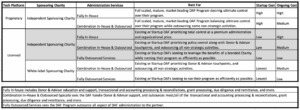In-House and Outsourced Service Options for Donor-Advised Fund Programs
Gideon Taub, Chief Strategy Officer
As the DAF ecosystem has matured, DAF Programs now have far more options available to them in terms of technology partners, services partners, and point solution vendors. My previous post shared my mapping of the DAF Landscape in the hopes of helping DAF market participants better understand the DAF Supply Chain and its participants. Today, I want to provide a guide to the options DAF programs have in terms of which core functions can be handled by in-house staff and those where partnering may be a better path forward.
The table below outlines the options, which for the most part can be mixed and matched, as desired. Additionally, a DAF program can choose to change from in-sourcing to out-sourcing (or vice versa) any part of their program as their program scales and matures. Of course, there are switching costs, but none of these decisions are forever. Today, I’ll share the options. In my next post, I’ll share the trends I’m seeing across the space.
Let’s dive in across the key decision point:
- Tech Platform
- Sponsoring Charity
- Administration Services

Tech Platform
The first major decision point is whether to build and maintain a proprietary technology platform or to partner with one of the vendors listed in the ‘DAF Administration Technology’ box in the DAF Landscape.
As the first national DAF programs were launching and scaling, there weren’t any great, reliable, scaled technology solutions, and so those programs ended up building out their own proprietary solutions, at great initial and ongoing expense.
Today, there are a handful of options for programs to choose from, where they can license technology and benefit from ongoing investment and improvements in those technology platforms. The best solutions are highly configurable effectively allowing programs to deliver a unique, differentiated program to meet the needs of their clients, donors, advisors, and wider community.
Sponsoring Charity
Another major decision point is around whether a program wants to create their own Public Charity to act as the ‘Sponsoring Charity’ for the DAF Program or whether they prefer to run their program as a program under one of the leading ‘Private-Label DAF’ providers, namely Renaissance Charitable Foundation (RCF) and National Philanthropic Trust (NPT).
Creating their own Public Charity does come with additional upfront cost in setting up the 501(c)(3), creating by-laws and policies, creating a Master Services Agreement (MSA) between the non-profit and for-profit entities (if needed), and the ongoing oversight required to operate a compliant Public Charity. This approach does afford the DAF the ultimate control of every aspect of their program. Note that if the DAF chooses to build it own DAF Tech platform, it would be most common and likely that they would also create their own Sponsoring Charity.
Alternately, DAF programs can operate as a Private-Label DAF, in partnership with a charity like RCF. Together, RCF and the DAF program will partner to determine all of the major policies of the program, including branding, minimums, fees, investment options, and many more. The charity is responsible for all of the compliance, reconciliations, tax and government filings, and more, while the DAF program can configure the major components of their program.
When working with Ren, there isn’t a cost difference between a DAF Program using their own sponsoring charity or leveraging RCF, so cost isn’t the key decision driver, but control is.
Administration Services
Finally, the DAF program must determine which services they will handle internally and which they’ll choose to outsource to a partner like Ren. This can be but doesn’t need to be an all or nothing decision. For example here are three very common approaches to in-sourcing/out-sourcing support services:
- Program A may choose to handle all of the services in-house. For programs that license their tech platform, they’re licensing it as a pure Software-As-A-Service offering, with their staff managing all of the services.
- Program B may choose to leverage their own employees for all Donor and Advisor-facing services (support, account opening, contributions, etc.), and out-source all back-office functions (reconciliations, charity due-diligence, grant distributions & payments, charity support, etc.) to their 3rd party partner.
- Program C may choose to outsource both the front-office and back-office service functions to their preferred partner. The services are fully private-labeled, so that when answering phone calls or emails, support staff will represent the DAF Program as if they’re internal staff for a seamless and trusted experience for Donors & Advisors!
Across these three options, they are listed from highest cost to the DAF Program to lowest. Organizations like Ren now have the scale and domain expertise to provide all of these Services more cost efficiently as compared to what it would cost any leading firm to hire, train, and manage those resources as full-time employees.
Reach out to us if you’re interested in discussing any of these options or combinations more extensively.
Note: This post is a part of a monthly blog series by Gideon Taub, Ren’s Chief Strategy Officer providing his perspectives on the DAF ecosystem, the latest trends, and insight into Ren’s vision. In addition to his role at Ren, Gideon leads the content and programming for the DAF Giving Summit. To make sure that you don’t miss any future posts, subscribe to Ren’s email list here, follow Gideon on LinkedIn, and join the DAF Giving Summit email list. Gideon founded Pinkaloo Technologies, which was acquired by Ren in 2021.
Gideon Taub, Chief Strategy Officer
Get an edge on charitable giving.
Sign up for our newsletter


